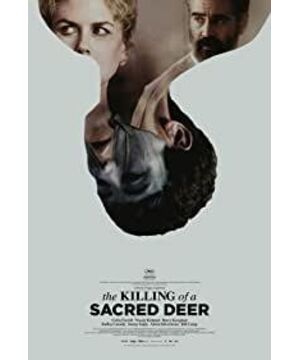Yesterday George watched The Death of the Sacred Deer, which won Best Screenplay at Cannes this year. The film was directed by "The Lobster" director Yorgos Lanthimos, with Colin Farrell and Nicole Kidd. Mann starring. The story of "The Death of the Sacred Deer" can actually be summed up as "The Revenge of the Patient's Family". Martin, the son of a patient who died on the operating table, took revenge against his father's chief surgeon "by virtue of" some supernatural power. .
Although the story can be summed up in one sentence, the theme of "Death of the Sacred Deer" is as slick as a loach: you can say that it is about revenge, but the class difference between the two sides of the contest is deliberately mentioned by the director; It is about redemption, but the doctor who "killed" Steven was forced to complete the process of redemption step by step. Film focus.
It is these many "ambiguities" that prevent us from approaching the core of what the author wants to express. And what we can clearly get in the second half of the movie is helplessness. It was the helplessness of a couple with superb medical skills in the face of the "disease" of their child. Of course, this "disease" is more like a "curse"; it is more of an excellent doctor who believes in science. Compromise of force majeure, This process of being forced to refresh their beliefs is also a kind of helplessness.
All this helplessness stems from one of the core fictions of the film, that is, the doctor Steven must kill one of his family members, so that the son and daughter's "rickets" can be cured, otherwise, the wife and children will die of disease.
It was Martin who brought this news to Steven. In this "showdown" between the big and the young, the relationship between the Steven family and the Martin family is worth pondering.
(Nicole Kidman's performance is restrained)
The first is the pairing of Martin and Steven. Martin single-mindedly believes that Steven is the one who "killed" his father. He hates Steven, but he also unknowingly regards Steven as his father and "loves" him. Steven felt guilty about Martin and took care of him at first, but when Martin showed his "love", Steven backed away.
Second is the relationship between Steven's son Bob and daughter Kim. As an older sister, Kim is so jealous of her younger brother that she even tried to "run away" at the last minute to avoid being killed.
Finally, there is the relationship between his wife Anna and Martin. There is a scene where Anna kneels in front of Martin and kisses Martin's feet, as if to beg his forgiveness, which represents Anna's "motherhood".
However, the most obscure relationship in this film is the love and killing between Steven and Martin, the "father and son" who are not father and son. This "love" makes the son become the father's "lover".
At the beginning of the film, the relationship between Steven and Martin was built according to the "underground couple" model. Steven often secretly dated Martin and secretly sent Martin expensive watches; he restricted Martin from coming to the hospital to find him, and concealed Martin's identity from his colleagues; he even invited Martin to be a guest at home, as if he was a "lover" and a "main room". "informal meeting". If the film does not reveal the relationship between the two, the audience will suspect that Steven and Martin are a same-sex couple who are "child lover" and "old lover".
By the end of the film, Steven lost his son Bob, and Martin lost his father early. This allows the two of them to complement each other's "father and son" identities. At the same time, it can also be considered that Martin "forced" this Steven to "kill" his son and welcomed the "new son" Martin.
(Uncle and Zhengtai)
What's more terrifying is the details of the film.
Martin and Kim walked close enough to see each other's half-naked bodies. But Martin was not interested in the perfect body of a developing girl, Kim, but wanted to see how much body hair Steven had on his uncle.
And Steven and Anna's married life is also quite "weird", requiring Anna to take off her clothes, Steven takes measures on his own to achieve a state of excitement.
Both Steven and Martin's "clinical manifestations" imply their "indifference" to women's bodies.
In the film, the "male-male relationship" between Steven and Martin is indirectly pointed out, which is a very obscure intertext. As a last resort, Steven told his son Bob a childhood secret. When he was just interested in his body, in order to "research" the body, he "drunk" his father when he was drunk. . Steven's lines also specifically emphasized that "he made a lot of liquid from his father". This direct physical contact, although not between Steven and Martin, completes the relationship between Steven and Martin in an intertextual form, in other words, this detail completes the Two people have always wanted to do but stopped themselves from doing things. It even explained from another side why Steven repeatedly dated Martin, why Martin was quite attached to Steven, and even gave gifts.
This "ambiguity" between father and son seems to be more taboo than same-sex love, and I think this is why the director expressed it in such a tortuous way. The director's soundtrack with a strong sense of sacredness forms a contrast with this "ambiguity", making it more taboo. At the same time, the director's extensive use of wide-angle lenses and a strong modern setting make the film a surreal style, making the "father and son love" more like falling into a cloud and uncapable. Sadly, the two female characters in the film, wife Anna and daughter Jin, are very smart, but they have to become supporting roles for the men around them. They try to use their "intelligence" to catch them, but men are chasing people of the same sex. Just a little alms in the process.
For more exciting movie reviews, please scan the QR code to follow "Things About Movies".
View more about The Killing of a Sacred Deer reviews










